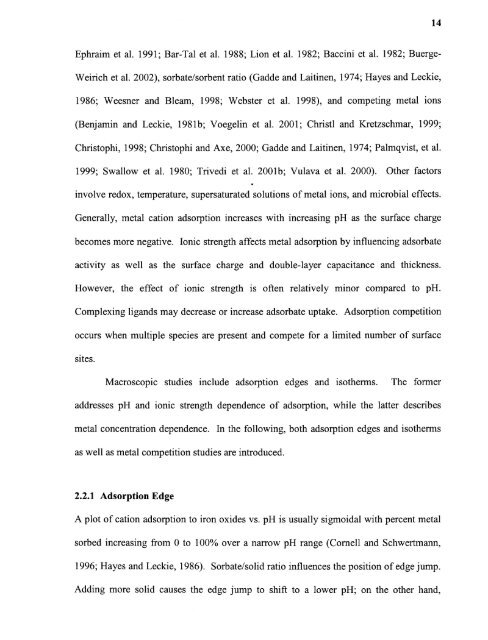Heavy metal adsorption on iron oxide and iron oxide-coated silica ...
Heavy metal adsorption on iron oxide and iron oxide-coated silica ...
Heavy metal adsorption on iron oxide and iron oxide-coated silica ...
You also want an ePaper? Increase the reach of your titles
YUMPU automatically turns print PDFs into web optimized ePapers that Google loves.
14Ephraim et al. 1991; Bar-Tal et al. 1988; Li<strong>on</strong> et al. 1982; Baccini et al. 1982; Buerge-Weirich et al. 2002), sorbate/sorbent ratio (Gadde <strong>and</strong> Laitinen, 1974; Hayes <strong>and</strong> Leckie,1986; Weesner <strong>and</strong> Bleam, 1998; Webster et al. 1998), <strong>and</strong> competing <str<strong>on</strong>g>metal</str<strong>on</strong>g> i<strong>on</strong>s(Benjamin <strong>and</strong> Leckie, 1981b; Voegelin et al. 2001; Christi <strong>and</strong> Kretzschmar, 1999;Christophi, 1998; Christophi <strong>and</strong> Axe, 2000; Gadde <strong>and</strong> Laitinen, 1974; Palmqvist, et al.1999; Swallow et al. 1980; Trivedi et al. 2001b; Vulava et al. 2000). Other factorsinvolve redox, temperature, supersaturated soluti<strong>on</strong>s of <str<strong>on</strong>g>metal</str<strong>on</strong>g> i<strong>on</strong>s, <strong>and</strong> microbial effects.Generally, <str<strong>on</strong>g>metal</str<strong>on</strong>g> cati<strong>on</strong> <str<strong>on</strong>g>adsorpti<strong>on</strong></str<strong>on</strong>g> increases with increasing pH as the surface chargebecomes more negative. I<strong>on</strong>ic strength affects <str<strong>on</strong>g>metal</str<strong>on</strong>g> <str<strong>on</strong>g>adsorpti<strong>on</strong></str<strong>on</strong>g> by influencing adsorbateactivity as well as the surface charge <strong>and</strong> double-layer capacitance <strong>and</strong> thickness.However, the effect of i<strong>on</strong>ic strength is often relatively minor compared to pH.Complexing lig<strong>and</strong>s may decrease or increase adsorbate uptake. Adsorpti<strong>on</strong> competiti<strong>on</strong>occurs when multiple species are present <strong>and</strong> compete for a limited number of surfacesites.Macroscopic studies include <str<strong>on</strong>g>adsorpti<strong>on</strong></str<strong>on</strong>g> edges <strong>and</strong> isotherms. The formeraddresses pH <strong>and</strong> i<strong>on</strong>ic strength dependence of <str<strong>on</strong>g>adsorpti<strong>on</strong></str<strong>on</strong>g>, while the latter describes<str<strong>on</strong>g>metal</str<strong>on</strong>g> c<strong>on</strong>centrati<strong>on</strong> dependence. In the following, both <str<strong>on</strong>g>adsorpti<strong>on</strong></str<strong>on</strong>g> edges <strong>and</strong> isothermsas well as <str<strong>on</strong>g>metal</str<strong>on</strong>g> competiti<strong>on</strong> studies are introduced.2.2.1 Adsorpti<strong>on</strong> EdgeA plot of cati<strong>on</strong> <str<strong>on</strong>g>adsorpti<strong>on</strong></str<strong>on</strong>g> to ir<strong>on</strong> <strong>oxide</strong>s vs. pH is usually sigmoidal with percent <str<strong>on</strong>g>metal</str<strong>on</strong>g>sorbed increasing from 0 to 100% over a narrow pH range (Cornell <strong>and</strong> Schwertmann,1996; Hayes <strong>and</strong> Leckie, 1986). Sorbate/solid ratio influences the positi<strong>on</strong> of edge jump.Adding more solid causes the edge jump to shift to a lower pH; <strong>on</strong> the other h<strong>and</strong>,
















